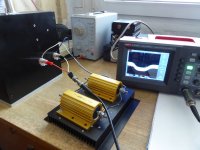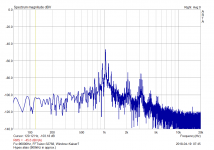A friend brought me a pair of Hypex Ncore NC400 little amplifiers to make some deeper analysis, based on my measurements. First, I would like to congratulate Bruno and the team to outstanding parameters of this amplifier in the audio frequency band. Very low noise (I measured -95dBV(A) at the output, negligible distortion of all kinds, no hum, no mains spurious components. So far so good. I was thinking about returning the amplifiers to the owner saying I have found nothing special. Then I got an idea to use old-fashioned stand-alone instruments and to make some measurements like long ago in the lab. I have connected an analog 10Hz – 1MHz generator to the input and observed amplifier voltage output shape on the scope screen. Everything fine up to 440kHz. And then it happened – though the input signal was only 21mV, it started to be evident that the amplifier, at least the piece that I have measured, has not designed an input anti-alias low pass filter properly. When the input frequency approaches to Fs (about 460kHz) and 2Fs (about 920kHz), one can see aliases, difference frequencies Fs – Fin (or 2Fs – Fin) appearing at the output of the amplifier. I measured about 56mVp-p output swing of the alias signals, in the audio band. I have put a 2xRC analog low pass filter (27kHz) at the scope input to remove 460 kHz switching frequency of the NC400. So, the input signal containing HF components may, under certain circumstances, create audible alias frequencies at the NC400 output. This is not very good and I guess that a better input anti-alias low pass analog filter would cure the situation.
Attached is my measuring place, the alias signal is stored in the scope memory. Please see analog low pass filter at the scope input to remove/reduce 460kHz switching frequency.
Attached is my measuring place, the alias signal is stored in the scope memory. Please see analog low pass filter at the scope input to remove/reduce 460kHz switching frequency.
Attachments
Last edited:
So, no worries?
These audible aliased sounds are excited by input level of only several mV. A spectrum of in-audio band alias is attached, input signal was near to 900kHz and input amplitude below 10mV. I am also attaching the recorded sound in a zipped wav file. Full scale level of the recording would be 1V. It sounds exactly like old heterodyne receiver.
These audible aliased sounds are excited by input level of only several mV. A spectrum of in-audio band alias is attached, input signal was near to 900kHz and input amplitude below 10mV. I am also attaching the recorded sound in a zipped wav file. Full scale level of the recording would be 1V. It sounds exactly like old heterodyne receiver.
Attachments
I had a Hypex NC500 based amplifier here some time ago.
During my work I listened to the radio through this amplifier.
Though sound quality was good (initially pretty impressive actually), it happened that after several hours of classical music listening I experienced listening fatigue, and I finally tended to switch off the music.
Switching back to a lateral mosfet based class A/B amplifier, this listening fatigue did not occur.
Could the phenomenon you measured have something to do with this?
During my work I listened to the radio through this amplifier.
Though sound quality was good (initially pretty impressive actually), it happened that after several hours of classical music listening I experienced listening fatigue, and I finally tended to switch off the music.
Switching back to a lateral mosfet based class A/B amplifier, this listening fatigue did not occur.
Could the phenomenon you measured have something to do with this?
A 460KHz input is not very likely from a line level source feeding an Ncore.
In fact, much more sensitive band was around 900kHz, twice the switching frequency of the modulator.
Yes, the input signal like that is not very likely, however, output spectrum of some digital sources is very nasty and contains frequencies "of interest". Only several mV of the "right" frequency signal triggers the occurrence of the alias frequencies. Almost independent on further change of the interference signal level.
Quite simple anti-alias input low pass filter, like double-RC or LC, would probably cure the issue completely.
This is a design feature. If you input conservative/liberal/religous talk radio it will "alias" the content to above-audio frequencies at your preference. 
DSP units that employ noise shaping can have some interesting content above 20khz, but I haven't seen one that has any RF output that would excite the conditions you're noting here.
That said, if you start inputting radio frequencies to any type of audio power amplifier, who knows what type of weird effects you might uncover.
If you feel this is an engineering oversight from Hypex, I suggest to contact them for some insight.
Dave.
DSP units that employ noise shaping can have some interesting content above 20khz, but I haven't seen one that has any RF output that would excite the conditions you're noting here.
That said, if you start inputting radio frequencies to any type of audio power amplifier, who knows what type of weird effects you might uncover.
If you feel this is an engineering oversight from Hypex, I suggest to contact them for some insight.
Dave.
This is a design feature.
Yes it is, and it could (should) have been solved by a circuit design - an appropriate input anti-alias low pass filter. The same "design feature" as for any sampled data system.
I have already contacted their technical support, so I will see if I get any answer.
Since there are so many of these units in the field, the question quickly becomes what would you recommend to solve the issue? (Especially for those who own these units and are not DIY-inclined.) RCR filter? Transformer coupling? Etc? Etc?
I suspect this will not be an issue for 99% of users since RF will not easily find its way into/onto the links between source and Ncore amplifier. Also, most folks component interfacing scheme probably has an inherent low-pass filter characteristic via the source output resistance and interconnect shunt capacitance.
In your testing, I suspect your signal generator is a voltage source and you used a short, wide-bandwidth interconnect cable? Worst-case scenario for highlighting this effect, but an interconnect scheme that most domestic hookups won't have.
Dave.
I suspect this will not be an issue for 99% of users since RF will not easily find its way into/onto the links between source and Ncore amplifier. Also, most folks component interfacing scheme probably has an inherent low-pass filter characteristic via the source output resistance and interconnect shunt capacitance.
In your testing, I suspect your signal generator is a voltage source and you used a short, wide-bandwidth interconnect cable? Worst-case scenario for highlighting this effect, but an interconnect scheme that most domestic hookups won't have.
Dave.
This connector to the AMPs should help
NC3MXX-EMC - Neutrik
I am not sure about any RFI at the AMP input inside the chassis with one or more SMPS.
NC3MXX-EMC - Neutrik
I am not sure about any RFI at the AMP input inside the chassis with one or more SMPS.
This connector to the AMPs should help
NC3MXX-EMC - Neutrik
I am not sure about any RFI at the AMP input inside the chassis with one or more SMPS.
Ehh… correcting myself….
These are not on the signal lines, so doesn’t help with RF inputs on them. Sorry.
I have not received a reply from Hypex technical support, but in an e-mail communication, B.P. has confirmed my findings and also confirmed that the most sensitive frequency range is near to 2 x switching frequency. So, for those who are interested, a decent LPF at the amplifier input should cure the issue.
If one were to emulate the equivalent of using an XLR male connector like "Neutrik-NC3FXX-EMC blocking XLR Male" on the input to the NC400 based amp -- what circuit, inductor or capacitor values and materials (e.g. ceramic cap) would you recommend?
Adding a capacitor, a ferrite, and AC-coupling the shield is what is being done in the Neutric RF-blocking connector: Neutrik NC3FXX-EMCB Cable Connector (Black) | NZ
Is there any reason why the same circuitry can't be added to the XLR female jack for the amplifier input -- instead of building a special RF-blocking preamp/DAC -> nc400 amplifier cable with aforementioned Neutrik connector.
Thanks,
- Niels.
Adding a capacitor, a ferrite, and AC-coupling the shield is what is being done in the Neutric RF-blocking connector: Neutrik NC3FXX-EMCB Cable Connector (Black) | NZ
Is there any reason why the same circuitry can't be added to the XLR female jack for the amplifier input -- instead of building a special RF-blocking preamp/DAC -> nc400 amplifier cable with aforementioned Neutrik connector.
Thanks,
- Niels.
If one were to emulate the equivalent of using an XLR male connector like "Neutrik-NC3FXX-EMC blocking XLR Male" on the input to the NC400 based amp -- what circuit,
- Niels.
Should have taken a closer look at NC3MXX-EMC - Neutrik for the circuit:

TBD: inductor and capacitor values?
- Status
- This old topic is closed. If you want to reopen this topic, contact a moderator using the "Report Post" button.
- Home
- Amplifiers
- Class D
- Hypex Ncore NC400 - input anti-alias filter?

